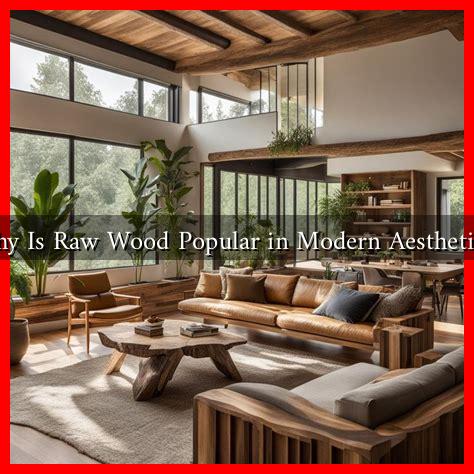-
Table of Contents
Why Is Raw Wood Popular in Modern Aesthetics?
In recent years, raw wood has emerged as a prominent feature in modern design aesthetics, captivating homeowners, architects, and interior designers alike. This trend reflects a broader movement towards natural materials and sustainable living, resonating with a growing desire for authenticity and connection to nature. But what exactly makes raw wood so appealing in contemporary aesthetics? This article explores the reasons behind its popularity, supported by examples and insights from the design world.
The Allure of Natural Materials
One of the primary reasons raw wood has gained traction in modern aesthetics is the increasing appreciation for natural materials. Unlike synthetic alternatives, raw wood offers unique textures, colors, and patterns that cannot be replicated. This authenticity is highly valued in a world where mass production often leads to uniformity.
- Unique Characteristics: Each piece of raw wood has its own distinct grain, knots, and imperfections, making it a one-of-a-kind material.
- Warmth and Comfort: The natural tones of wood create a warm and inviting atmosphere, enhancing the overall comfort of a space.
- Connection to Nature: Incorporating raw wood into design fosters a sense of connection to the natural world, which is increasingly important in urban environments.
Sustainability and Eco-Friendliness
As environmental concerns continue to rise, many consumers are seeking sustainable options for their homes. Raw wood, particularly when sourced responsibly, aligns with eco-friendly practices. Here are some key points regarding its sustainability:
- Renewable Resource: Wood is a renewable resource, especially when harvested from sustainably managed forests.
- Carbon Sequestration: Trees absorb carbon dioxide during their growth, making wood products a carbon-neutral option when sourced responsibly.
- Biodegradable: Unlike synthetic materials, wood is biodegradable, reducing waste in landfills.
According to a report by the Forest Stewardship Council (FSC), sustainably sourced wood can significantly reduce the environmental impact of construction and design projects. This has led to a surge in demand for raw wood products in both residential and commercial spaces.
Versatility in Design
Raw wood’s versatility makes it suitable for various design styles, from rustic to modern minimalist. Designers are increasingly incorporating raw wood into different elements of a space, including:
- Furniture: Tables, chairs, and shelving made from raw wood add character and warmth to any room.
- Wall Treatments: Exposed wooden beams and paneling create a striking visual impact while maintaining a natural feel.
- Decorative Accents: Smaller items like wooden bowls, sculptures, and picture frames can enhance the aesthetic without overwhelming the space.
For instance, the Scandinavian design movement has embraced raw wood for its simplicity and functionality, often using it in furniture and architectural elements to create a harmonious balance between form and function.
Case Studies: Successful Implementations of Raw Wood
Several notable projects have showcased the beauty and functionality of raw wood in modern design:
- The Treehouse by Studio B Architects: This residential project features extensive use of raw wood, blending seamlessly with its forested surroundings. The design emphasizes sustainability and a connection to nature.
- Apple Park: Apple’s headquarters in Cupertino, California, incorporates raw wood in its interior design, creating a warm and inviting atmosphere that reflects the company’s commitment to sustainability.
These examples illustrate how raw wood can be effectively integrated into various architectural and design contexts, enhancing both aesthetic appeal and environmental responsibility.
Conclusion
The popularity of raw wood in modern aesthetics can be attributed to its unique characteristics, sustainability, versatility, and successful implementations in design. As consumers increasingly seek authentic and eco-friendly options, raw wood stands out as a material that not only enhances the beauty of spaces but also aligns with a more sustainable lifestyle. By embracing raw wood, designers and homeowners alike can create environments that are not only visually stunning but also deeply connected to the natural world.
For more insights on sustainable design practices, visit the Forest Stewardship Council.

